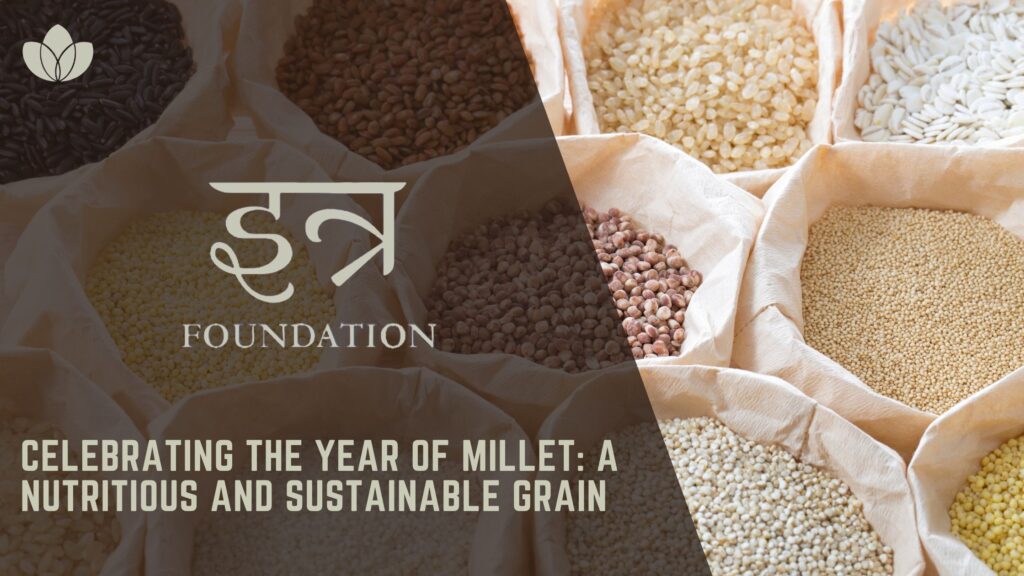Millet is a nutritious and versatile grain that has been a staple in various cultures and cuisines for centuries. In recent years, millet has gained recognition for its numerous health benefits, as well as its potential as a sustainable and drought-resistant alternative to other grains. In honor of this ancient grain, the United Nations has declared 2023 as the “Year of Millet”. This designation aims to increase awareness and understanding of the many ways in which millet can contribute to food security, nutrition, and sustainable agriculture. In this article, we will explore the benefits of millet, share some delicious millet-based recipes, and offer ideas for how to celebrate the Year of Millet.
The benefits of millet
Millet is a nutritious grain that is high in fiber, low on the glycemic index*, and naturally gluten-free. It is also rich in minerals such as magnesium, phosphorous, and potassium, as well as B vitamins and antioxidants. Consuming millet has been shown to improve digestion, lower cholesterol levels, and reduce the risk of certain diseases such as diabetes and heart disease. In addition to its health benefits, millet is also a sustainable and drought-resistant crop that can be grown in a variety of climates and soil conditions. As a result, it has the potential to play a significant role in addressing global food security and promoting sustainable agriculture practices. In terms of economics, millet can be a cost-effective grain for both farmers and consumers, as it requires fewer inputs (such as water and pesticides) and can thrive in areas with poor soil quality. Millet’s versatility and low cost make it a valuable resource for communities around the world, and supporting the production and consumption of millet can help contribute to economic stability and growth.
Millet recipes and meal ideas
Millet is a delicious and versatile grain that can be used in a variety of traditional Indian recipes. Some tasty millet-based dishes include jhangora ki kheer (millet pudding), bajra roti (millet flatbread), and rajgira paratha (millet pancakes). Millet can also be used as a substitute for rice in dishes like bajra khichdi (millet porridge) and bajra pulao (millet pilaf). To incorporate millet into everyday meals, try adding it to salads, soups, and grain bowls, or using it as a substitute for rice or other grains in recipes. Millet can also be ground into flour and used in baking, such as in bread, muffins, and cookies. When cooking with millet, it is important to rinse it well before cooking and to use a ratio of 2:1 (water to millet) for the best results. With a little creativity, it is easy to incorporate millet into your diet in a variety of delicious and nourishing ways.
How to celebrate the Year of Millet
There are many ways that individuals, communities, and organizations can celebrate the Year of Millet and promote the benefits of this ancient grain. Some ideas include:
- Incorporating millet into your diet by trying out new millet-based recipes and meal ideas
- Sharing information about millet with friends, family, and social media followers
- Participating in events or campaigns that promote the Year of Millet and the benefits of millet
- Donating to organizations that support the production and distribution of millet as a sustainable and nutritious food source
By getting involved in the Year of Millet, you can help raise awareness about the many ways in which millet can contribute to food security, nutrition, and sustainable agriculture. There are many resources available for learning more about millet and finding millet-based products, such as the United Nations’ Year of Millet website and social media channels. So, let’s celebrate the Year of Millet and make a positive impact on the world.
Conclusion
In conclusion, the Year of Millet is a great opportunity to celebrate the many benefits of this nutritious and versatile grain. Millet is high in fiber, low on the glycemic index*, and naturally gluten-free, making it a healthy choice for people of all ages. It is also a sustainable and drought-resistant crop that has the potential to contribute to global food security and support sustainable agriculture practices. There are countless delicious ways to incorporate millet into your diet, from classic dishes like millet porridge and pilaf to more innovative creations like millet burgers and millet-stuffed peppers. By learning about millet and supporting the Year of Millet, we can all help raise awareness about the importance of this ancient grain and make a positive impact on the world. ITRA Foundation is promoting the Year of Millet through educational workshops, cooking demonstrations, and seminars on the many benefits of millet. By supporting these efforts and spreading the word about millet, we can help ensure that this valuable resource receives the attention and support it deserves.
glycemic index*: The glycemic index (GI) is a measure of how quickly a food increases blood sugar levels. Foods with a high GI cause a rapid increase in blood sugar, while those with a low GI have a slower and more gradual effect. This can be important for people who need to manage their blood sugar levels, such as those with diabetes.




Good to know about Millets! Would like to be part of the workshops being arranged on this nutritious grain!
Thank you Priya we will surely inform you about it once organized.